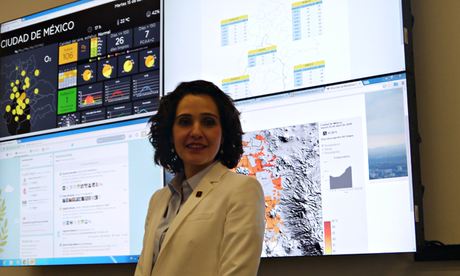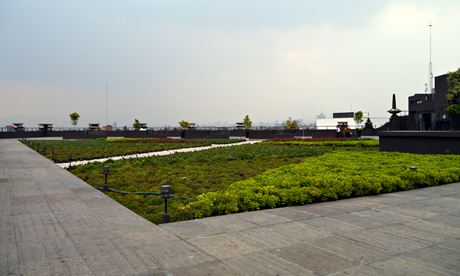theguardian.com,

Mexico City's green roofs are helping to purge the capital of air pollution. Photograph: Marco Ugarte/AP
In a sheltered corner of one of the greatest megacities on Earth, there is a place where lizards careen around tree trunks, butterflies drink nectar from vermillion flowers and hummingbirds whisk the heavy air with their wings.
Stand in the botanical gardens of the Bosque de Chapultepec (the Chapultepec forest) and listen carefully enough, and something remarkable happens: birdsong begins to pierce the groan of trucks and the screech of taxi horns from the long avenue that bisects the park.
The gardens are home to one of a growing number of azoteas verdes – or green roofs – that are springing up around Mexico City as part of the metropolis's efforts to purge its air of the pollution that has long been among its least-desired claims to fame.
The azotea verde atop the circular single-story offices of the botanical gardens, is planted with hardy stonecrop, which can withstand the Mexico City summer, but which also produces oxygen and serves as a filter to draw out the carbon dioxide and heavy metal particles in the air. As well as providing the park's squirrels with an arena in which to practise their parkour, the roof help regulates the temperature of the offices below and soaks up rainwater to keep the building dry.
Last year, the city's environment secretariat spent almost $1m (£595,000) on the azoteas verdes project, bringing the total area of green roofs in hospitals, schools and government buildings to 21,949 sq m. This year, the investment will rise by a third.
Mexico City's environment secretary, Tanya Müller, says: "In a city like ours where urban development puts pressure on the space we have at ground level, we have to take advantage of our rooftops to create a green urban infrastructure."
 Mexico City's environment minister Tanya Müller stands in front of a screen showing live updates on pollution in the city
Mexico City's environment minister Tanya Müller stands in front of a screen showing live updates on pollution in the cityThe green roofs do far more than simply purify the air: they reduce the "heat island effect", teach children about nature and speed up the recuperation rates of hospital patients, she adds.
A little way across town, not far from the city's ancient heart, the Zócalo, sits the secretariat's air-monitoring lab. It too has been given over to greenery and from its neatly planted roof, where dedicated staff congregate for lunchtime exercise classes, the haze that blankets the capital is plain to see. It smudges the outlines of distant towerblocks, as well as the mountains that enclose the city and its 21 million inhabitants. But, as Müller is keen to point out, fighting air pollution demands rather more technological solutions than sowing seeds on rooftops.
Her glass-and-steel office, which overlooks the Zócalo, feels like a curious hybrid of an internet startup office and an architectural practice. On the wall by her desk is an enormous screen with a live Twitter feed and electronic maps showing the temperature and ozone levels of Mexico City and the surrounding area. On a wet April afternoon, the ozone levels are creeping above the normal levels, but other pollutants are within the usual range.
"I have this dashboard on my smartphone and it's the same dashboard as the department of air monitoring has and the mayor has," Müller says. "We know how the air quality is every day and whether we have to take decisions."
Readings from the 29 air-monitoring stations in the city and the surrounding state of Mexico can trigger a variety of responses. If pollution levels are seriously high and remain so for 48 hours, the environment secretariat's Hoy No Circula (No driving today) ban kicks in, and those cars with registration plates of a certain colour and two-digit code are not allowed on the roads.
Anyone found driving when they shouldn't be has their plates taken away and must pay what Müller describes as a very harsh fine of 20 days' pay based on the Mexico City minimum wage. "Even though the measures aren't very popular – we're the first administration not to have suspendedHoy No Circula for any holiday – they are very responsible," she adds proudly.
Unsurprisingly, Müller, who cycles to work, is a big fan of pedal power. The two mountain bikes parked in a rack outside her office, up the stairs from the Diego Rivera murals that decorate the walls, suggest that her staff are too.
 A garden on the roof of the environment secretary's air-monitoring labs in Mexico City
A garden on the roof of the environment secretary's air-monitoring labs in Mexico CityBy expanding the city's Metro system and investing in the Ecobici bike hire scheme – which is used for about 26,000 journeys a day – she hopes to wean people off their dependence on cars. "We still have a long way to go: although 80% of the population uses public transport, the city is still very car-orientated," Müller says. "What we're trying to do is make people conscious of how you use you car: it has to be in a much more rational and responsible manner."
Other initiatives to improve the city's air quality over the past two decades – such as moving refineries beyond its boundaries and introducing cleaner buses – appear to be paying off. Between 1990 and 2012, levels of ozone fell from 43 parts per billion to 27 parts per billion; sulphur dioxide from 55 parts per billion to five parts per billion, and carbon monoxide from 84 parts per billion to 10 parts per billion.
Muller says air quality is her priority "because it has an impact on your health and that obviously has consequences for your quality of life". She adds: "We're working on air quality and climate change together, because whatever we do for air quality and emissions will have a positive effect on climate change. At the end of the day, we want a city that can offer better quality of life for its citizens."
Mexico City's efforts to clean up its act have not gone unnoticed; Müller recently met officials from Tehran who wanted to compare notes, while members of the C40 Cities Climate Leadership Group have also shown interest in the city's smartphone apps.
As Mexico begins to shrug off its smog and attendant grimy reputation, Müller believes its strategies could help cities further north. "What's very interesting for us is what's happening right now in Paris and London: we somehow have this perception that in these very developed, first-world European cities with great transport and infrastructure, you've overcome these issues of air quality," she says.
"But we're seeing that it's not so. The origin and the problem is the same: it's the use of private automobiles. People need to know that even if you have a great public transport system, if you do not rationalise private car use, you're going to have problems."

No hay comentarios:
Publicar un comentario